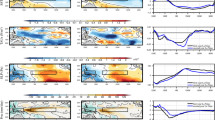Abstract
Possible causes behind the unusual cooling by summer monsoon clouds over India are investigated. Results suggest that the causes behind the cooling over the Bay of Bengal, India (BBI) and Arabian Sea (AS) within the Indian monsoon region are different. Over the BBI, clouds are tall. A unique upper tropospheric easterly jet stream exists over India during the summer monsoon season, which horizontally spreads the vertically growing deep convective clouds and thereby increases the cloud cover. Hence, more incoming solar radiation is reflected back to space, which leads to cooling. A radiative transfer study employing the Santa Barbara DISORT Atmospheric Radiative Transfer model supports this view. Over the Arabian Sea, clouds are shallow, and hence the upper tropospheric jet cannot affect them. Due to their proximity to the ground, Arabian Sea clouds exert less warming effect, but they exert a considerable cooling effect, which arises because of the high reflectivity of the clouds. Over the Equatorial Indian Ocean (EIO), where the monsoon clouds originate and propagate towards the monsoon trough region, both cooling and warming effects are nearly canceled out. The upper tropospheric jet is located hundreds of kilometers north of the EIO, and hence it does not disturb the deep convective clouds of the EIO. Therefore, they behave similarly to other deep convective clouds in the tropical belt.











Similar content being viewed by others
References
Harrison EF, Barkstrom BR, Ramanathan V, Cess RD, Gibson G (1990) Seasonal variation of cloud radiative forcing derived from the Earth Radiation Budget Experiment. J Geophys Res 95:18.687–18.703
Kalnay E, Kanamitsu M, Kistler R, Collins W, Deaven D, Candin L, Iredell M, Saha S, White G, Woollen J, Zhu Y, Chelliah M, Ebisuzaki W, Higgins W, Janowiak J, Mot KC, Ropelewski C, Wang Leetmaa A, Reynolds R, Jenne Roy, Joseph Dennis (1996) The NCEP/NCAR 40-Year Reanalysis Project. Bull Am Meteor Soc 77:437–471
Kiehl JT (1994) On the observed near cancellation between longwave and shortwave cloud radiative forcing in tropical regions. J Clim 7:559–565
Narayanan MS, Rao BM (1981) Detection of monsoon inversion by TIROS-N satellite. Nature 294:546–548
Rajeevan M, Srinivasan J (2000) Net cloud radiative forcing at the top of the atmosphere in the Asian monsoon region. J Clim 13:650–657
Ricchiazzi P, Yang S, Gautier C, Sowle D (1998) SBDART: a research and teaching software tool for plane-parallel radiative transfer in the earth’s atmosphere. Bull Am Meteo Soc 79:2101–2114
Rossow WB et al (1996) International Satellite Cloud Climatology Project (ISCCP)—Documentation of new cloud data sets. WMO/TD-737, World Climate Research Programme (ICSU and WMO), Geneva
Sathiyamoorthy V, Pal PK, Joshi PC (2004) Influence of the upper-tropospheric wind shear upon cloud radiative forcing in the Asian monsoon region. J Clim 17:2725–2735
Sathiyamoorthy V, Pal PK, Joshi PC (2007) Intraseasonal variability of the tropical easterly jet. Meteorol Atmos Phy 96:305–316. doi:10.1007/s00703-006-0214-7
Stamnes K, Tsay S, Wiscombe W, Jayaweera K (1988) Numerically stable algorithm for discrete-ordinate-method radiative transfer in multiple scattering and emitting layered media. Appl Opt 27:2502–2509
Weare BC (1997) Climatic variability of cloud radiative forcing. Quart J Roy Meteor Soc 123:1055–1073
Wielicki BA, Barkstrom BR, Baum BA, Charlock TP, Green RN, Kratz DP, Lee RB III, Minnis P, Smith GL, Wong T, Young DF, Cess RD, Coakley JA, Crommelynck DAH, Donner L, Kandel R, King MD, Miller AJ, Ramanathan V, Randall DA, Stowe LL, Welch RM (1998) Clouds and the Earth’s radiant energy system (CERES): algorithm overview. IEEE Trans Geosci Rem Sen 36:1127–1141
Zuidema P, Mapes B (2008) Cloud vertical structure observed from space and ship over the Bay of Bengal and the Eastern Tropical Pacific. J Met Soc Jpn 86A:205–218
Author information
Authors and Affiliations
Corresponding author
Additional information
Responsible editor: J. Fasullo.
Appendix
Appendix
SBDART is a combination of a sophisticated, discrete ordinate radiative transfer module with a low-resolution atmospheric transmission model and is designed for analysis of a wide variety of RT problems encountered in satellite remote sensing. In SBDART, the radiative transfer equations are numerically integrated with a discrete ordinate radiative transfer (DISORT) module (Stamnes et al. 1988). This method uses a numerically stable algorithm to solve the equations of plane-parallel radiative transfer in a vertically inhomogeneous atmosphere (Ricchiazzi et al. 1998). In SBDART, the intensity of scattered and thermally emitted radiation can be computed at different directions and heights. Computations can be performed in up to 65 atmospheric layers and 40 radiation streams. The radiative processes included in the model are Rayleigh scattering, gaseous absorptions, cloud and aerosol scattering and absorptions. The simulation was done by keeping the cloud cover range as observed in various cloud data over the study region. The computation of radiative transfer in a cloudy atmosphere required knowledge of different scattering parameters, which are computed in SBDART using a Mie-scattering code for spherical cloud droplets with statistical distribution of the drop radius. For radiative transfer through cloud, the parameters considered are the altitude of the cloud layer, its optical thickness and droplet size. In SBDART, altitudes of cloud layers (km) can be specified as separate cloud layers or as a range of altitudes that will be filled by cloud.
Rights and permissions
About this article
Cite this article
Sathiyamoorthy, V., Shukla, B.P. & Pal, P.K. A study on radiative properties of Indian summer monsoon clouds. Meteorol Atmos Phys 113, 55–66 (2011). https://doi.org/10.1007/s00703-011-0140-1
Received:
Accepted:
Published:
Issue Date:
DOI: https://doi.org/10.1007/s00703-011-0140-1




